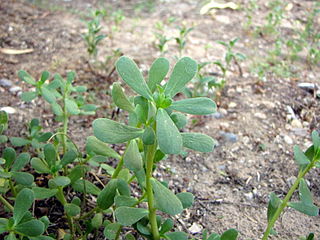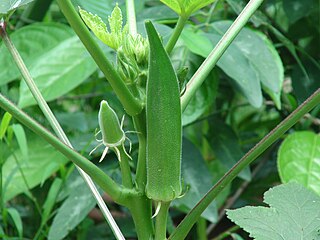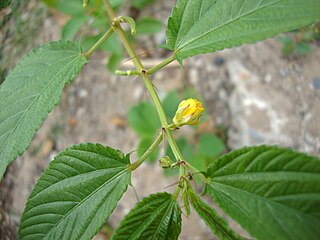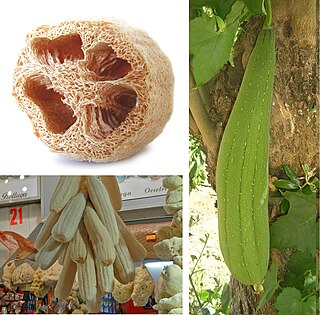
Celery is a marshland plant in the family Apiaceae that has been cultivated as a vegetable since antiquity. Celery has a long fibrous stalk tapering into leaves. Depending on location and cultivar, either its stalks, leaves or hypocotyl are eaten and used in cooking. Celery seed powder is used as a spice.

Sesame is a plant in the genus Sesamum, also called benne. Numerous wild relatives occur in Africa and a smaller number in India. It is widely naturalized in tropical regions around the world and is cultivated for its edible seeds, which grow in pods. World production in 2018 was 6 million metric tons, with Sudan, Myanmar, and India as the largest producers.

Patchouli is a species of flowering plant in the family Lamiaceae, commonly called the mint or deadnettle family. The plant grows as a bushy perennial herb, with erect stems reaching up to 75 centimetres (2.5 ft) in height and bearing small, pale pink-white flowers.

The cardoon, Cynara cardunculus, also called the artichoke thistle, is a thistle in the family Asteraceae. It is a naturally occurring species that also has many cultivated forms, including the globe artichoke. It is native to the western and central Mediterranean region, where it was domesticated in ancient times and still occurs as a wild plant.

Portulaca oleracea is an annual succulent in the family Portulacaceae.

Chayote, also known as mirliton and choko, is an edible plant belonging to the gourd family, Cucurbitaceae. This fruit was first cultivated in Mesoamerica between southern Mexico and Honduras, with the most genetic diversity available in both Mexico and Guatemala. It is one of several foods introduced to the Old World during the Columbian Exchange. At that time, the plant spread to other parts of the Americas, ultimately causing it to be integrated into the cuisine of many Latin American nations.

The winged bean, also known as cigarillas, goa bean, four-angled bean, four-cornered bean, manila bean, princess bean, asparagus pea, dragon bean, is a tropical herbaceous legume plant.

Ipomoea aquatica, widely known as water spinach, is a semi-aquatic, tropical plant grown as a vegetable for its tender shoots. I. aquatica is generally believed to have been first domesticated in Southeast Asia. It is widely cultivated in Southeast Asia, East Asia, and South Asia. It grows abundantly near waterways and requires little to no care.

Taro is a root vegetable. It is the most widely cultivated species of several plants in the family Araceae that are used as vegetables for their corms, leaves, and petioles. Taro corms are a food staple in African, Oceanic, and South Asian cultures. Taro is believed to be one of the earliest cultivated plants.

Okra or Okro, Abelmoschus esculentus, known in many English-speaking countries as ladies' fingers or ochro, is a flowering plant in the mallow family. It has edible green seed pods. The geographical origin of okra is disputed, with supporters of West African, Ethiopian, Southeast Asian, and South Asian origins. Cultivated in tropical, subtropical, and warm temperate regions around the world, okra is used in the cuisines of many countries.

Sesamum is a leguminous crop and genus of about 20 species in the flowering plant family Pedaliaceae. The plants are annual or perennial herbs with edible seeds. The best-known member of the genus is sesame, Sesamum indicum, the source of sesame seeds. The species are primarily African, with some species occurring in India, Sri Lanka, and China. The origin of S. indicum is uncertain, as it is widely cultivated and naturalized in tropical regions. The genus is closely related to the strictly African genus Ceratotheca and is itself probably African in origin.

Eddoe or eddo is a tropical vegetable often considered identifiable as the species Colocasia antiquorum, closely related to taro, which is primarily used for its thickened stems (corms). In most cultivars there is an acrid taste that requires careful cooking. The young leaves can also be cooked and eaten, but they have a somewhat acrid taste.

Canna indica, commonly known as Indian shot, African arrowroot, edible canna, purple arrowroot, Sierra Leone arrowroot, is a plant species in the family Cannaceae. It is native to much of South America, Central America, the West Indies, and Mexico. It is also naturalized in the southeastern United States, and much of Europe, sub-Saharan Africa, Southeast Asia, and Oceania. Canna indica has been a minor food crop cultivated by indigenous peoples of the Americas for thousands of years.

Cnidoscolus aconitifolius, commonly known as chaya, tree spinach, or spinach tree, is a large, fast-growing and leafy perennial shrub that is believed to have originated in the Yucatán Peninsula of Mexico. The specific epithet, aconitifolius, means "Aconitum-like leaves". It has succulent stems that exude a milky sap when cut.

Moringa oleifera is a fast-growing, drought-resistant tree of the family Moringaceae, native to the Indian subcontinent. Common names include moringa, drumstick tree, horseradish tree, and ben oil tree or benzolive tree.

Perilla frutescens, commonly called deulkkae, perilla or Korean perilla, is a species of Perilla in the mint family Lamiaceae. It is an annual plant native to Southeast Asia and Indian highlands, and is traditionally grown in the Korean peninsula, southern China, Japan and India as a crop.

Jute mallow or nalta jute is a species of shrub in the family Malvaceae. Together with C. capsularis it is the primary source of jute fiber. The leaves and young fruits are used as a vegetable, the dried leaves are used for tea and as a soup thickener, and the seeds are edible.

Luffa aegyptiaca, the sponge gourd, Egyptian cucumber or Vietnamese luffa, is an annual species of vine cultivated for its fruit, native to South and Southeast Asia.

Ceratotheca sesamoides is a flowering plant in the genus Ceratotheca. It is indigenous to Africa and grows both as a wild weed and locally cultivated species, and is colloquially referred to as false sesame owing to its marked similarities with common sesame. The plant is most commonly cultivated in the African Savannah and other semi-arid areas on the continent and is found across Africa in both tropic and sub-tropic regions, usually growing in sandier soils south of the Sahara. It can be identified by numerous hairs on the stem, its pink flowers often replete with brown and purple dots and a sub-erect growth habit. A plant with many practical uses, the leaves and flowers are often consumed as vegetables or used in sauces. The leaves can also have medicinal benefits while the seeds can be employed to produce cooking oil. Despite its many uses and growing domestication at a local level, the plant remains predominantly underused and undervalued.

Sesamum alatum is a species of flowering plant in the Pedaliaceae. It is in the same genus as sesame. In English it is called winged-seed sesame. Its native range spans from Western Sahara to Egypt and south to KwaZulu-Natal in South Africa.




















